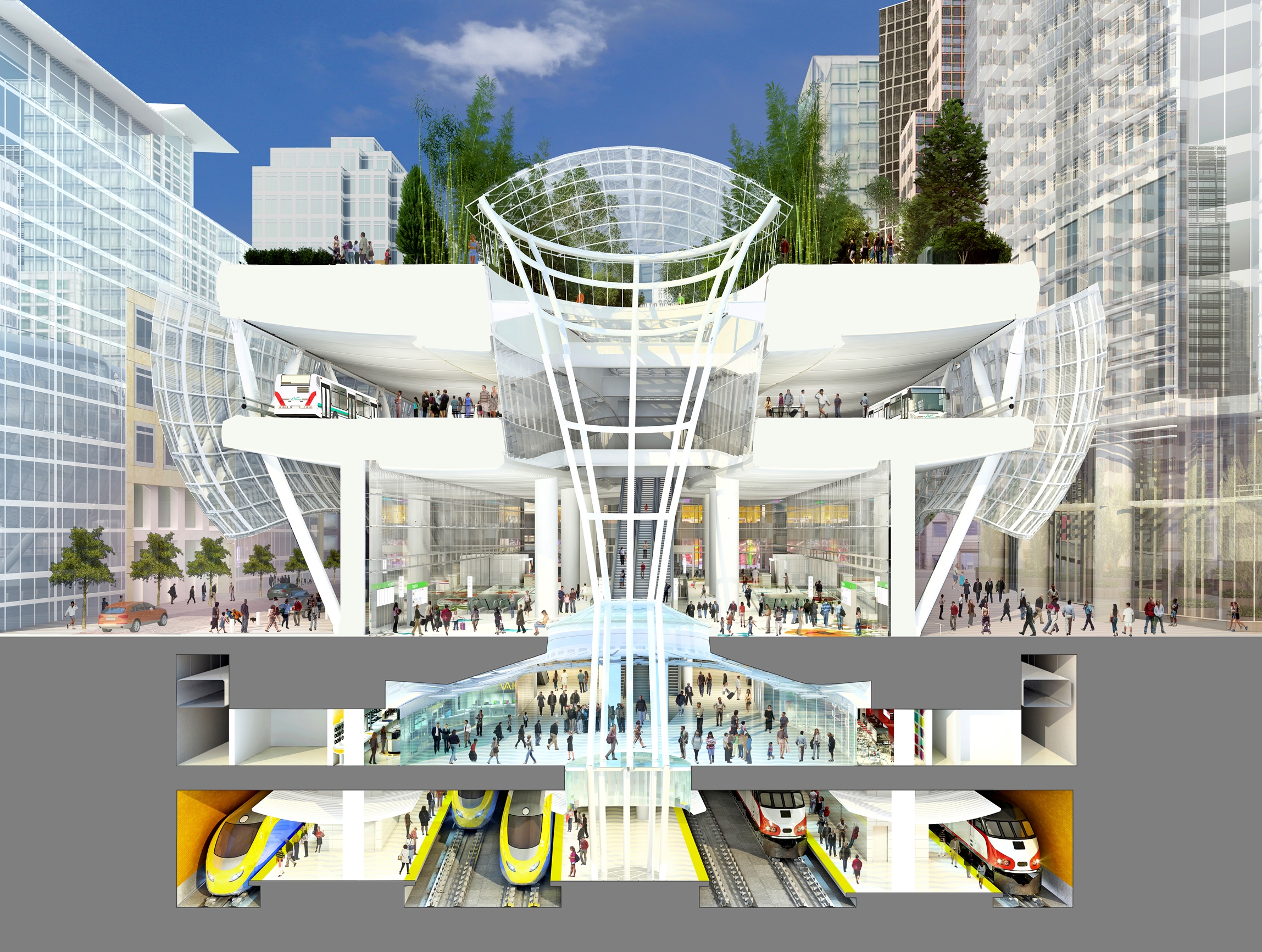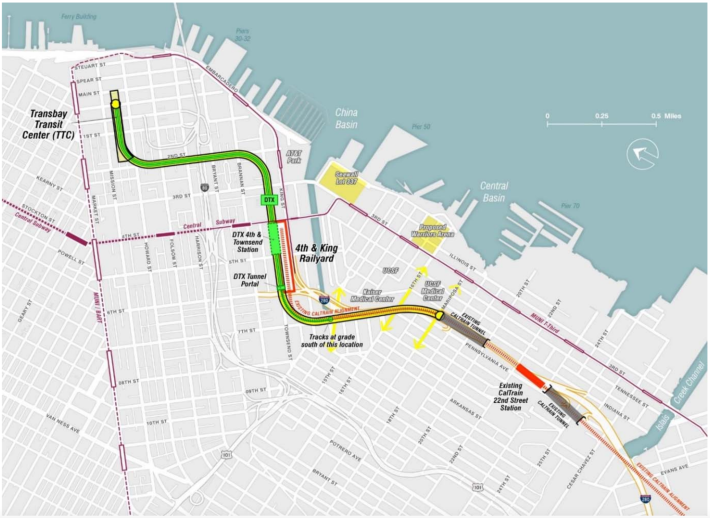Op-Ed: For Downtown Rail Extension To Make Sense, 280 Has To Go
4:00 PM PST on December 9, 2021

The “Grand Central Station of the West,” is built. Now the bottom level needs its trains. Image: CAHSR.
Note: GJEL Accident Attorneys regularly sponsors coverage on Streetsblog San Francisco and Streetsblog California. Unless noted in the story, GJEL Accident Attorneys is not consulted for the content or editorial direction of the sponsored content.
Major changes are coming to the Caltrain line as it passes through the eastern neighborhoods of San Francisco and into downtown. Long in the works, Downtown Extension (DTX) is a $4 billion project that will extend Caltrain from its current terminus at 4th & King to the Salesforce Transit Center, sending the trains through a subway tunnel buried under Townsend St and 2nd St. A new subway station will be added under 4th St at Townsend, and future California High Speed Rail trains will use the tracks as well as Caltrain.
Now, this project is to be complemented by the Pennsylvania Avenue Extension (PAX), which could extend the DTX tunnel south under 7th St and Pennsylvania Ave all the way to 25th St, where it will tie back into the existing Caltrain line. As part of this project the existing 22nd St station may have to be rebuilt as a subway station under Pennsylvania Ave, either at 22nd St or shifted a few blocks north to Mariposa St. The cost is a cool $2.8 billion, plus likely several hundred million more for the subway station.

There’s just one problem with this plan - it’s completely nuts.
It’s important to get Caltrain and High Speed Rail trains to the Salesforce Transit Center, and while the $4 billion price tag is certainly eye-watering, there’s no denying that the DTX project is a necessity. But, an additional project that adds about $3 billion to eliminate two grade crossings and build an unnecessary subway station right next to a freeway? That’s a plan that requires a lot more scrutiny before being allowed to proceed.
To understand how we got here we need to go back to 2014, when SF Planning began what was then known as the Railyard Alternatives & I-280 Boulevard (RAB) study. This study was kicked off as a response to the California High Speed Rail Authority’s plans to grade separate the tracks by trenching 16th St and Mission Bay Dr underneath them, creating an ugly mess of underpasses that the city quite understandably balked at. The objective was to examine several interconnected issues; most importantly, is there a better way to get trains to the Salesforce Transit Center, and could demolishing the last mile of I-280 and replacing it with a boulevard help find it?

It’s obvious why demolishing the northern end of I-280 was considered, as there’s a really simple solution to the problem of the ugly underpasses. Instead of trenching 16th St and Mission Bay Dr under the Caltrain tracks, it’s quite possible to trench the Caltrain tracks under the streets instead. From the northern end of the existing tunnel at Mariposa St, the tracks would descend into a trench, pass under 16th St, continue in a cut-and-cover tunnel, and cross under Mission Bay Dr before tying into the DTX at the Caltrain yard.
But for this to happen, I-280 needs to be removed; the maze of supporting columns surrounding the Caltrain tracks makes it impossible to dig a two track wide tunnel underneath the freeway.

So far, so much common sense. And yet as the study progressed, things started to unravel. The project’s community advisory committee was divided on the importance of removing the freeway. The audience at a community outreach meeting at Potrero Hill Recreation Center in February 2016 resembled less a gathering of concerned citizens and more an angry mob armed with pitchforks and flaming torches, ready to run out of town any planner who dared suggest removing the freeway. The city, afraid that their primary goal of avoiding the ugly underpasses was getting out of sight, started to reconsider their approach.
By the time the final reports were released in 2018 the project had been renamed the Rail Alignment & Benefits study, a clunky name contrived to paint over the consideration of boulevarding I-280 while retaining the same RAB abbreviation. The discussion of boulevarding I-280 takes up three pages in the 50 page executive summary report, and is heavily slanted towards discrediting the idea. A public records request asking for any communications between staff discussing the reason for renaming the study did not return any records, a response which is both laughable and suspicious.
The idea of trenching the Caltrain tracks under 16th St and Mission Bay Dr is not mentioned at all in the executive summary report, which only discusses the Pennsylvania Avenue alignment and another alignment through Mission Bay as alternatives to the ugly underpasses. The accompanying technical report does consider trenching the Caltrain tracks as alternative, but the study assumes that the freeway will remain, rendering the alignment impossible to construct. In a masterful catch-22, the technical report eliminates the alternative because the freeway makes it infeasible, but also notes that the interface with the freeway was not considered because the alternative had already been eliminated.

And that’s how we end up with a $3 billion subway to solve a problem that could be solved for a fraction of the cost by removing an aging and decaying piece of freeway infrastructure.
When faced with difficult trade-offs it’s much easier to throw money at a problem than to spend political capital standing up for the right approach, especially when that money is nowhere close to being appropriated and spent and the political consequences will be felt immediately. Without oversight, this project risks becoming our own version of BART to Silicon Valley Phase II, a project that has ballooned to $9.1 billion in large part due to an insistence that Santa Clara Street not be disturbed during construction. If we want the public to trust us with a $100 billion mega-measure to implement the Link 21 regional rail mega-project, we must do better at designing affordable capital projects and delivering them on time and on budget.
The only way forward for this project is to go back to the drawing board and consider options that allow I-280 to be removed. We have the time to do this project right; getting started on the DTX should be the priority, and that project will eat up any funding available for the next few years. Eventually there will be enough trains on the line that it becomes impractical to have the crossing gates down for so long and grade separation will become a necessity, but in the medium term Caltrain and HSR can use the existing tracks to access 4th & King and the Salesforce Transit Center.

In a recent presentation to the public, SF Planning staff displayed a map that showed that the communities surrounding the Caltrain rail line in San Francisco are considered to be Environmental Justice communities; areas that disproportionately bear the burden of environmental impacts. What they didn’t mention was that the reason for this designation was less because of the presence of the rail line and more because of the freeway that follows its path into downtown San Francisco. Removing the last mile of I-280 is not just a smart move to make this project more affordable, it’s a step towards rectifying the mistakes of the past and building a city that is livable for all of its residents.
***
Jon Bate is an organizer with the advocacy group Streets for People
Stay in touch
Sign up for our free newsletter
More from Streetsblog San Francisco
Weekend Roundup: Bancroft Lane Gets Concrete, Party in Downtown S.F.
...and the Bay Bridge to get its lights back
Richmond-San Rafael Bridge Bike Lane Will Need Support
There's no evidence the bike lane contributes to congestion on the bridge
Update on Oakland DOT’s Lakeshore Protected Bike Lane Project
Public seems fairly positive and accepting towards the coming project. Let's hope it stays that way




